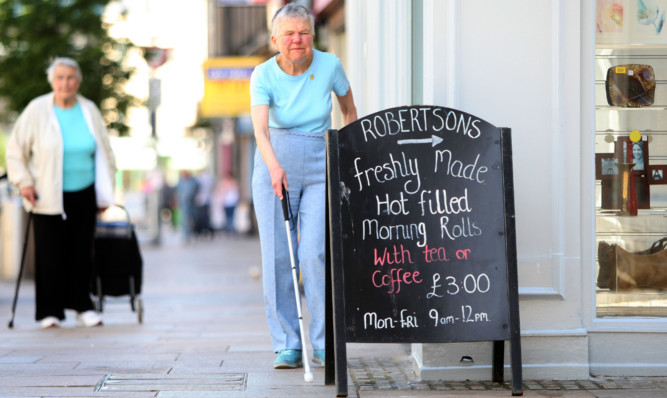A major campaign has been launched to rid our high streets of clutter as it emerged a third of people with sight problems have been injured by pavement obstacles.
Some blind and partially-sighted people who took part in the study said the felt so intimidated they ended up staying isolated in their homes.
Launching a new Street Charter, sight loss charity RNIB said thousands of people face challenges getting around their local area every day.
Advertising boards, bollards, bins, cars parked on pavements and shared space schemes were the most common obstacles encountered.
Spearheading the move is RNIB Scotland chairwoman Sandra Wilson, who is blind and lives in Kirkcaldy.
She told The Courier: “Personally I have frequent encounters with advertising boards, bins and badly parked cars, and recently almost broke a couple of teeth on what appeared to be a jutting out railing.
“Paradoxically, pedestrian precincts are particularly hazardous as the absence of vehicles seems to attract even more street furniture.
“I know it’s difficult to keep our streets obstacle-free but if decision-makers understood better how blind and partially-sighted people navigate the street environment, they could help tackle one of the biggest barriers faced by people with sight loss.”
With more than 180,000 people living with a significant level of sight loss north of the border, RNIB Scotland’s director John Legg said he knew it was impossible for streets to always be free of clutter but more could be done to make them accessible.
RNIB Scotland is calling on councils to review their policies on the most common obstacles and engage with blind and partially-sighted residents to put accessibility at the heart of local planning.
The Street Charter, as proposed by RNIB, would see councils and local campaigners with sight loss agree on the actions to take.
Mr Legg said: “A Street Charter needs to be flexible enough to take into account the local geography, characteristics and features of an area, while at the same time being shaped by the knowledge of people most affected.”
One suggestion is to invite councillors and officials to try walking a short distance while they are blindfolded, accompanied by a local resident with sight loss.
